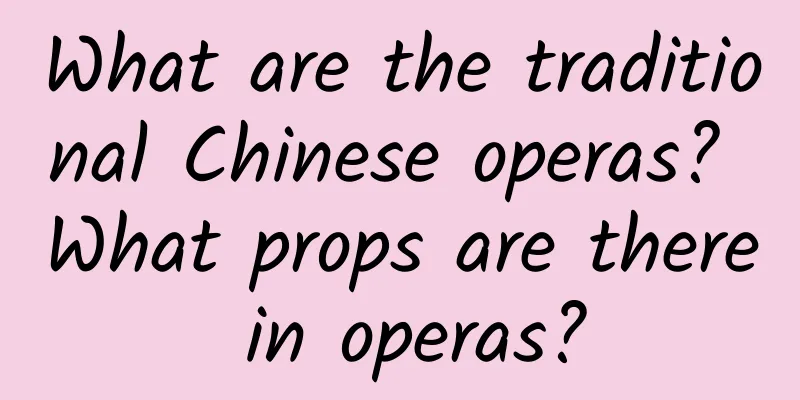What are the traditional Chinese operas? What props are there in operas?

|
Huangmei Opera is known as one of the "five major Chinese operas" along with Peking Opera, Yue Opera, Ping Opera, and Henan Opera. Peking Opera is the most popular and influential opera in my country and is known as the quintessence of the country. Kunqu Opera is known as the ancestor of all operas. As you can see, my country's traditional operas are rich and diverse. What are the specific details? Let's take a closer look. Contents of this article 1. What are the traditional Chinese operas? 2. What props are there in opera? 3. The birthplace of China's five major opera genres 1What are the traditional Chinese operas?There are dozens of traditional Chinese operas, including Peking Opera, Kunqu Opera, Gaoqiang Opera, Bangzi Opera, Pingju Opera, Hebei Bangzi Opera, Jin Opera, Pu Opera, Shangdang Bangzi Opera, Yan Opera, Qinqiang Opera, Errentai Opera, Ji Opera, Longjiang Opera, Henan Opera, Yue Opera, Henan Qu Opera, Shandong Bangzi Opera, Lv Opera, Huai Opera, Shanghai Opera, Comedy Opera, Yue Opera, Ying Opera, Shao Opera, Hui Opera, Huangmei Opera, Min Opera, Putian Opera, Liyuan Opera, Gaojia Opera, Gan Opera, Caicha Opera, Han Opera, Xiang Opera, Qi Opera, Hunan Flower Drum Opera, Yue Opera, Chaozhou Opera, Gui Opera, Caidiao Opera, Zhuang Opera, Sichuan Opera, Qian Opera, Yunnan Opera, Dai Opera, Tibetan Opera, and Shadow Play. Among them, Peking Opera is the most popular and influential opera in my country, and is known as the quintessence of the country; Kunqu Opera is known as the ancestor of all operas. Other operas such as Pingju Opera, Hebei Bangzi Opera, Errentai Opera, Ji Opera, Qinqiang Opera, Henan Opera, etc. are also very influential operas. 2What props are there in opera?1. Common props include a table and two chairs. 2. The tools used in the official case include official seals, fortune sticks, tiger-head plaques, water and fire sticks, four treasures of the study, imperial edicts, etc. 3. Palace props include dragon-phoenix fans, sun-moon fans, lanterns, golden pumpkins, dragon-phoenix flags, yellow umbrellas, talismans, poor boards, cloud-shaped pieces, horse whips, and boat oars. 4. There are the most daily props, including wine sets, tea sets and various production and daily necessities. 5. Martial arts props, including various knives, guns, swords, whips, coppers, hooks, hammers, axes, halberds, etc. 6. Animal-shaped props, including tigers, dogs, snakes, moles, etc. 3The birthplace of China's five major opera genresHuangmei Opera (Hubei), Peking Opera (Beijing), Yue Opera (Zhejiang), Henan Opera (Henan), Ping Opera (Hebei). 1. Peking Opera: Peking Opera, formerly known as Ping Opera, is one of the five major Chinese opera genres. It focuses on freehand brushwork in scene arrangement, with Xipi and Erhuang as the main tunes, and is accompanied by huqin, gongs and drums. It is regarded as the quintessence of China and the "first" of the three top Chinese operas. 2. Yue Opera: China's second largest opera, known as the second national opera, also known as the "most widely spread local opera". Some people believe that it is the "largest local opera genre". It is known as "Chinese opera" abroad. 3. Huangmei Opera: Huangmei Opera, formerly known as Huangmei Tune and Tea Picking Opera, originated in Huangmei, Hubei, and developed and grew in Anqing, Anhui. Huangmei Opera is known as one of the "Five Major Chinese Operas" along with Peking Opera, Yue Opera, Ping Opera and Henan Opera. It is also the main local opera in Anhui Province. There are also professional and amateur Huangmei Opera performance groups in Hubei, Jiangxi, Fujian, Zhejiang, Jiangsu, Hong Kong, Taiwan and other places, and it is widely popular. 4. Pingju: Pingju is a type of opera that is popular in northern China. It is one of the most popular operas among the people and is one of the five major operas in China. It was once considered to be the second largest opera in China. It was formed in the late Qing Dynasty on the basis of the folk song "Duikou Lianhualuo" in Luan County, Hebei Province. It was first popular in rural Hebei and later entered Tangshan, where it was called "Tangshan Luozi". 5. Henan Opera: Henan Opera is the largest local opera in China and ranks first among all local operas in China. In 2006, the number of state-owned professional Henan Opera groups counted by the national cultural department was 163, making it the opera with the largest number of professional opera groups and practitioners in the country, and the second among the top three Chinese operas. |
<<: What happens when the brain and muscles lose connection?
>>: What are the characteristics of opera in the Tang Dynasty?
Recommend
4 tips for women to become rich, beautiful and white in one month
Sometimes female friends only pay attention to wh...
Why is the vaginal discharge always yellow?
Leucorrhea is a substance secreted by every woman...
When is the best time to have an abortion?
With the development of society and the openness ...
What are the effects of excessive menstruation on the body?
A 30-year-old woman from another place had been s...
Can breast lumps be cured?
Many women feel that their life is very difficult...
What diseases will women suffer from without sex?
For those couples who are in the stage of love an...
Is Chinese medicine or Western medicine better for irregular menstruation?
Many girls now have irregular menstruation. Do yo...
Can women walk after abortion?
Nowadays, many middle school and high school stud...
What causes nephritis in women?
With the changes of the times, today's societ...
Is a positive iodine test normal?
Gynecological diseases are common diseases for ma...
Are tampons comfortable to use?
Ever since women started menstruating, they have ...
Can breasts develop again?
The size of a woman's breasts is not only rel...
Does Houttuynia cordata have any effect on pregnant women?
Pregnant women are a very special group. After pr...
What to do if you have intermittent bleeding after abortion
What should you do if you have intermittent bleed...









